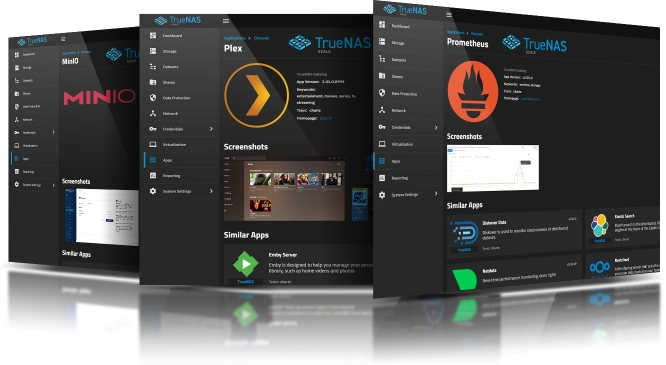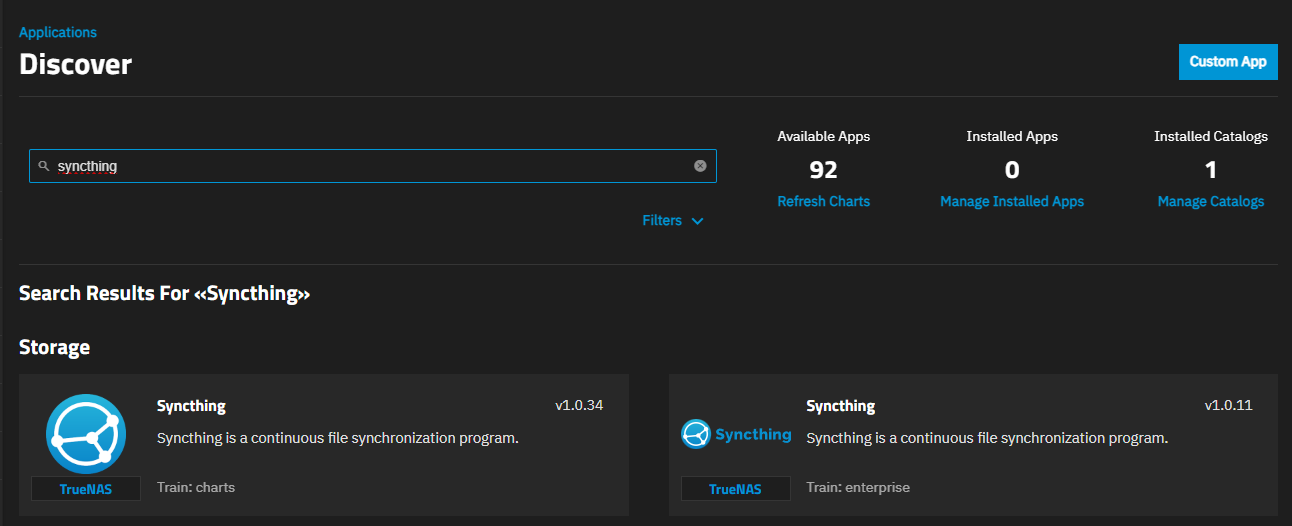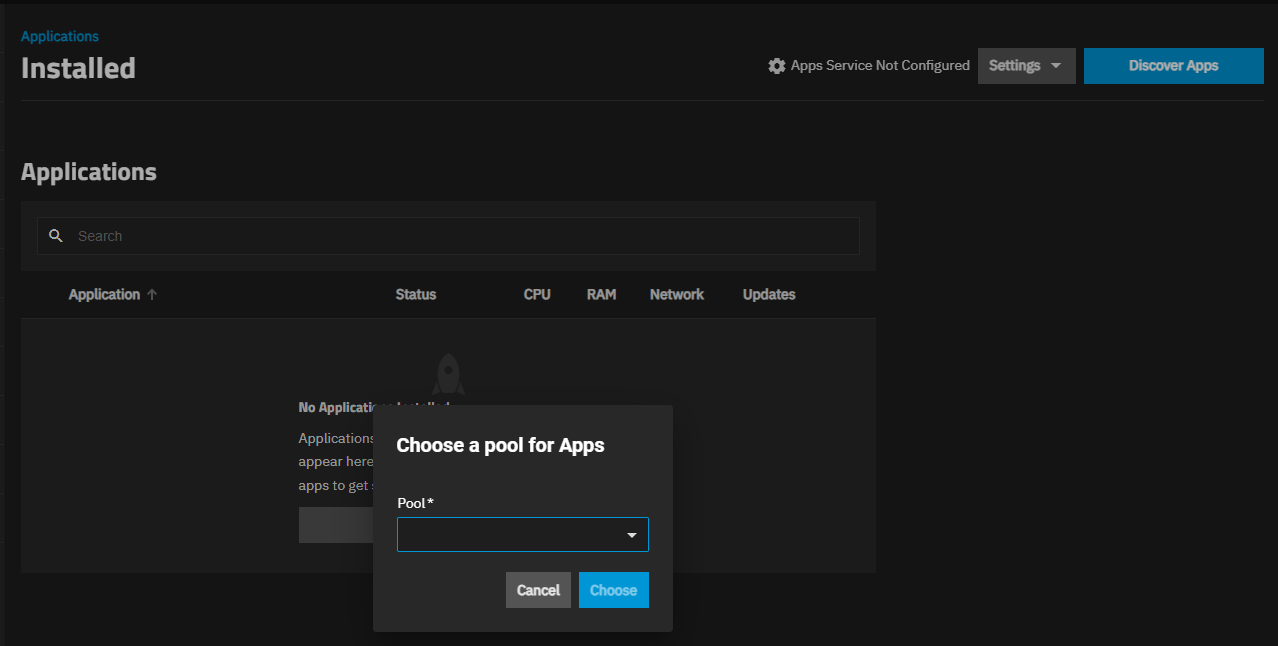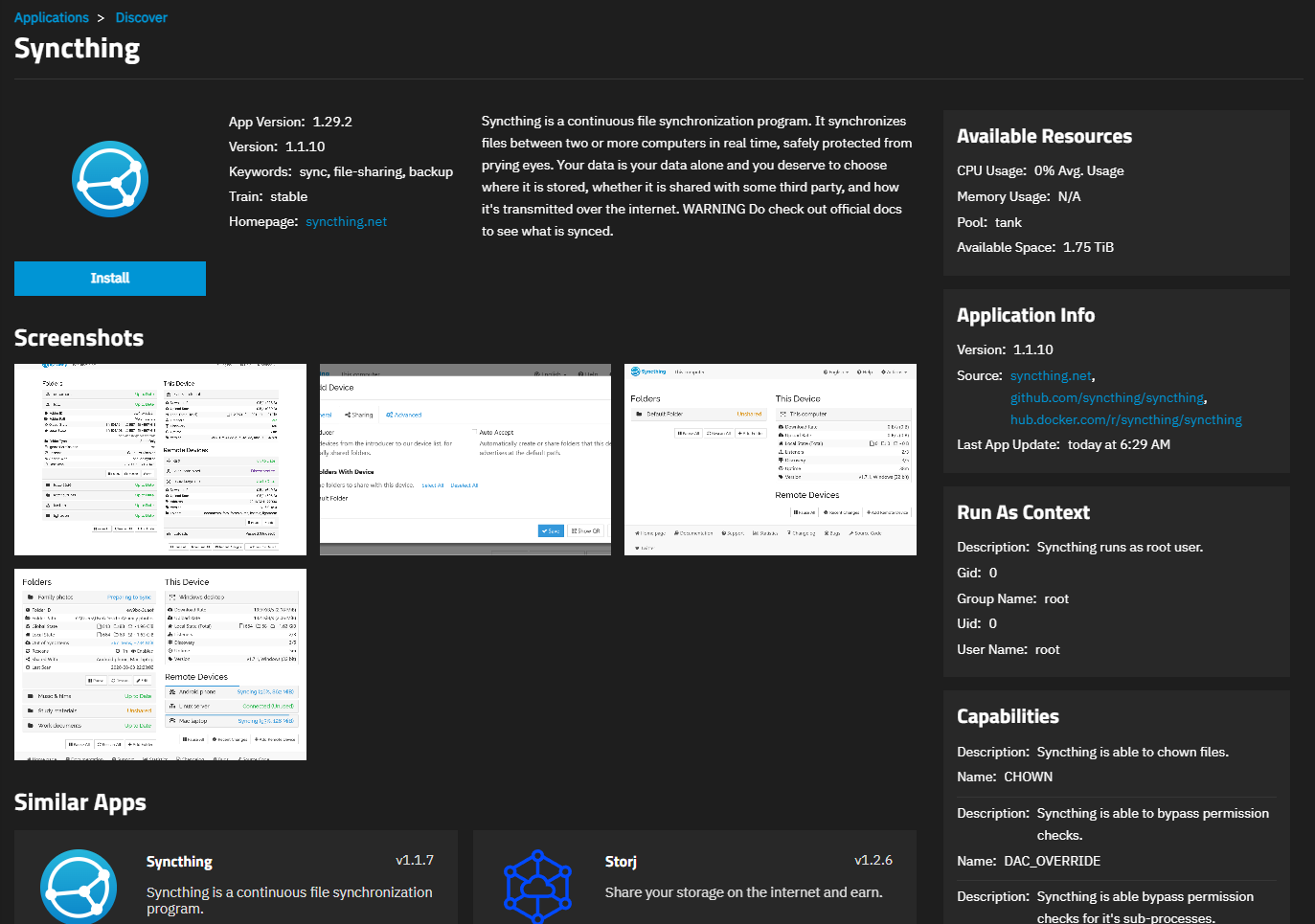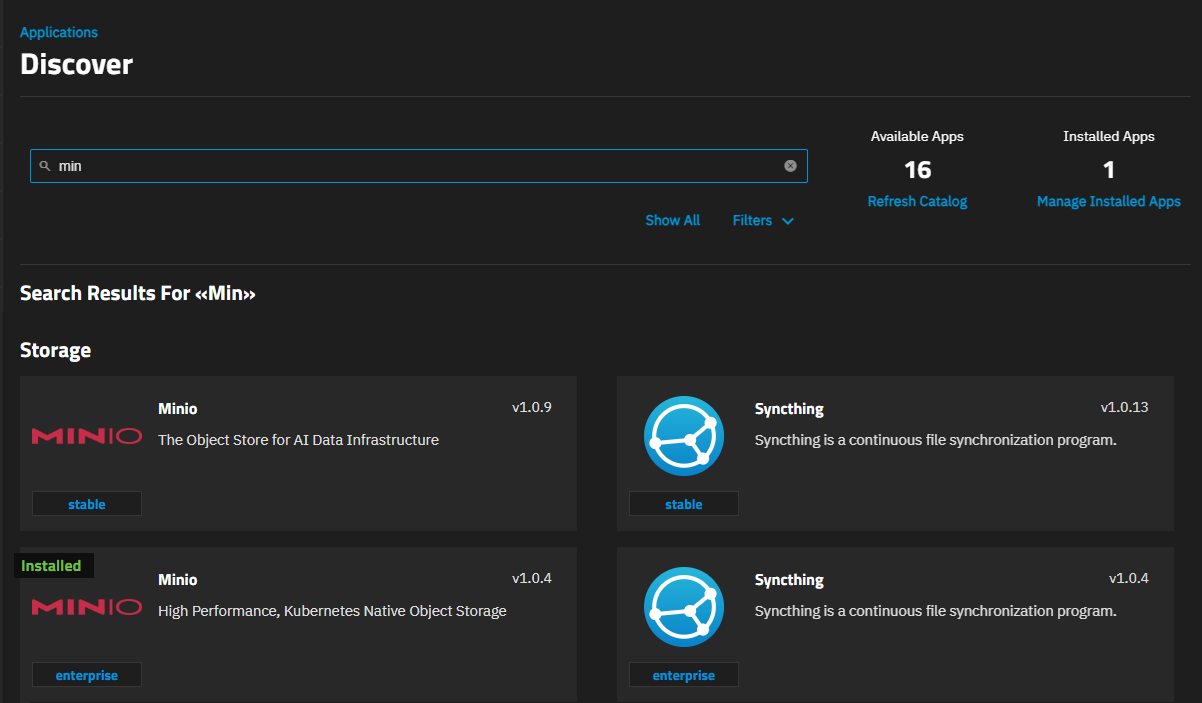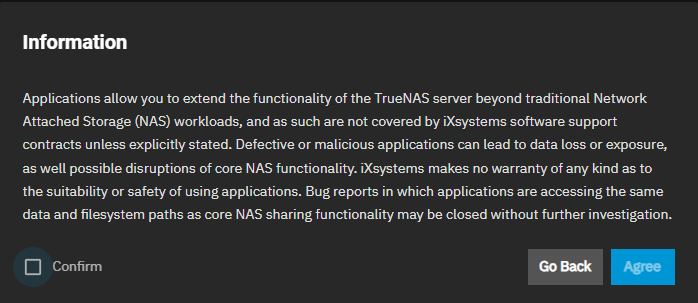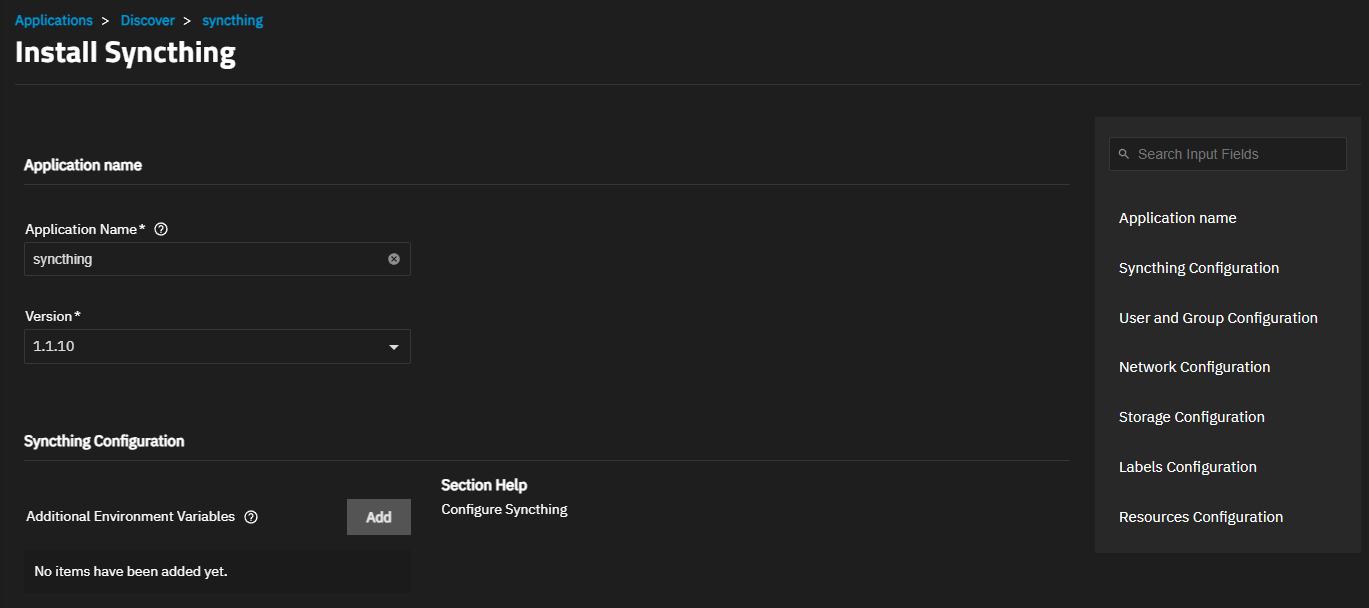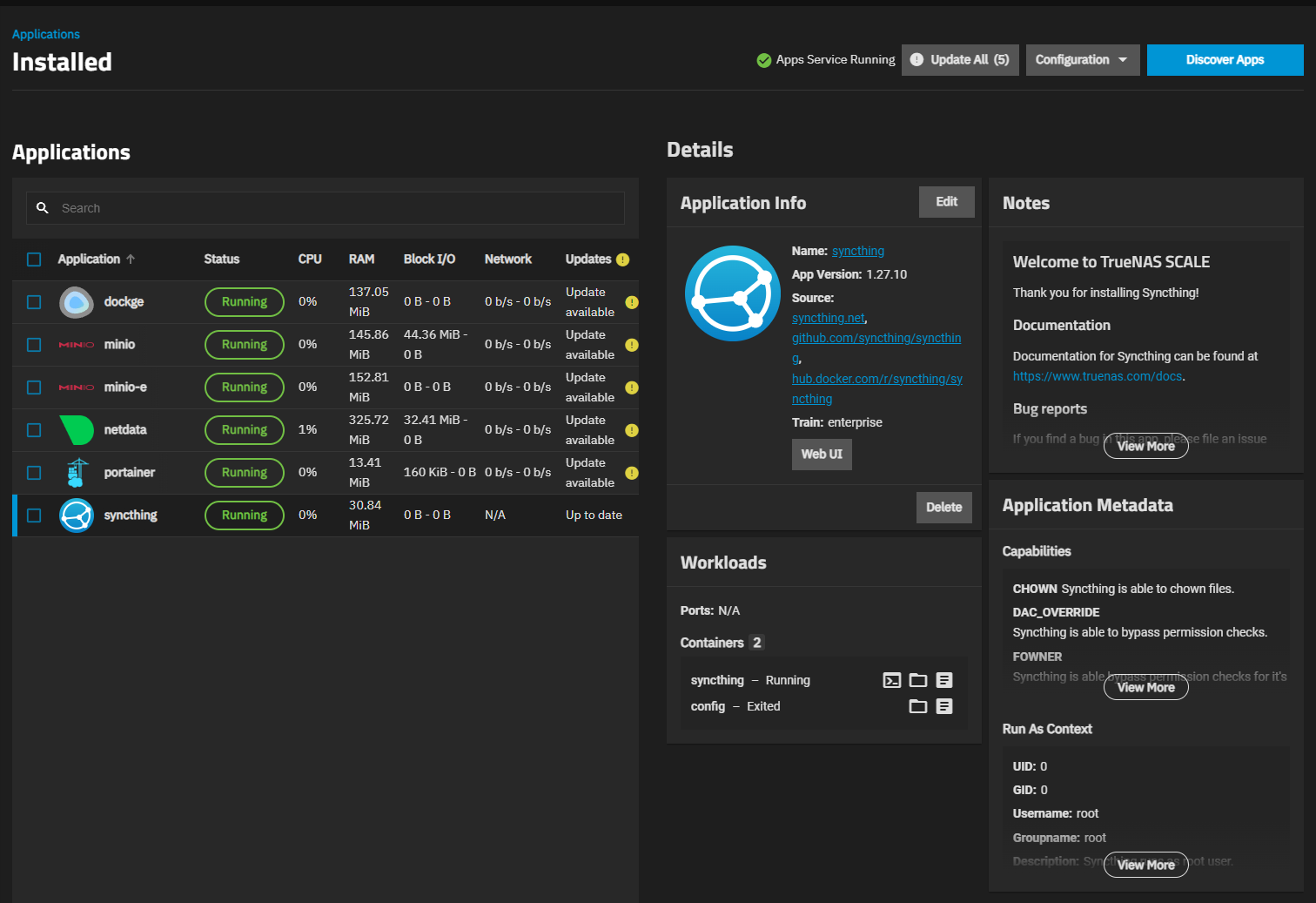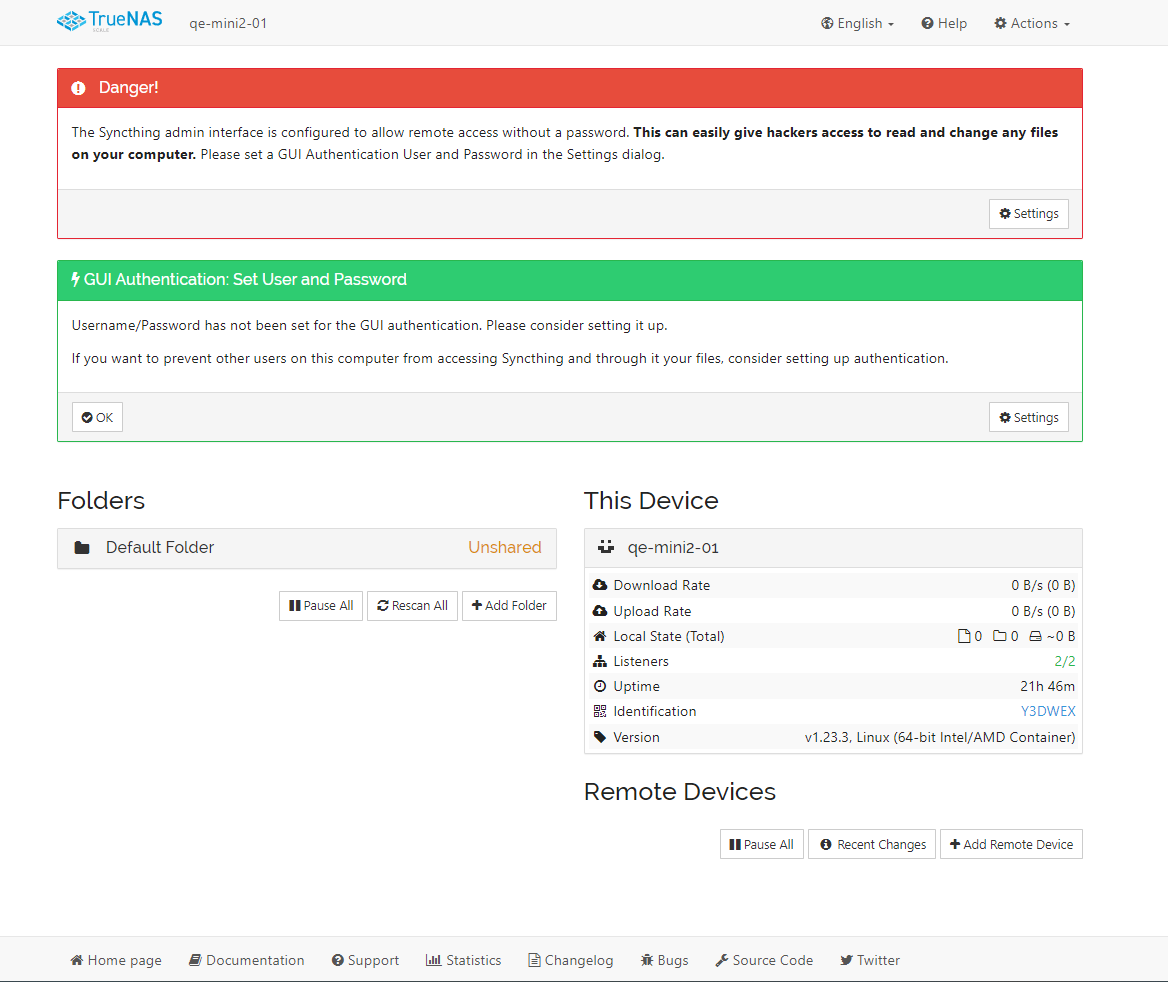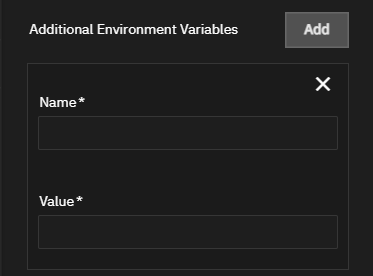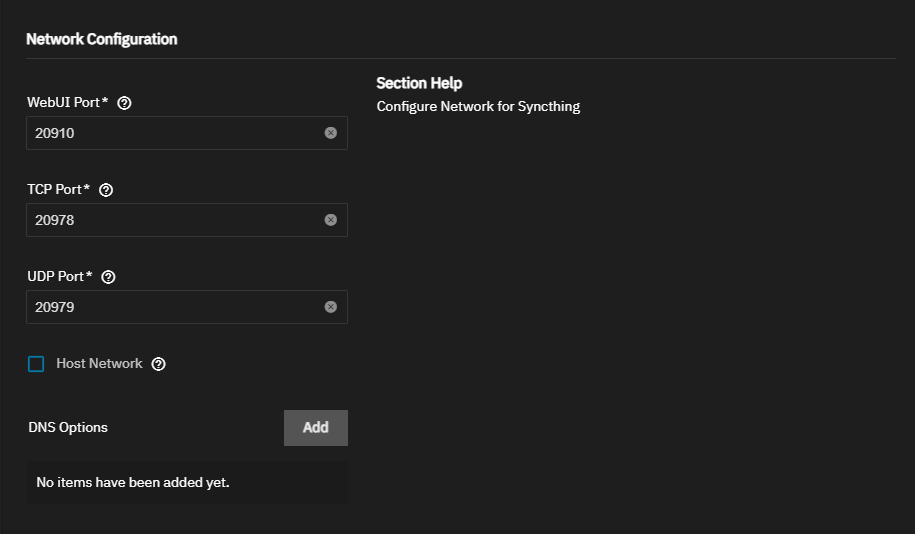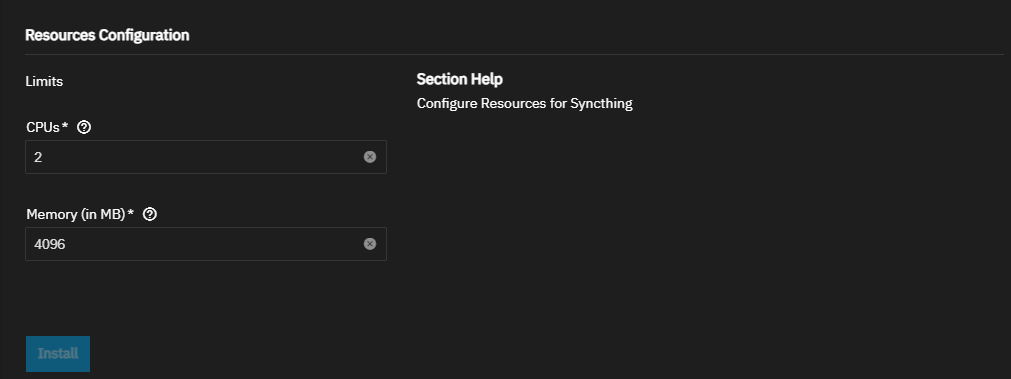Syncthing (Stable) Deployment
Support and documentation for applications within the Stable catalog is handled by the TrueNAS community. The TrueNAS Applications Portal hosts but does not validate or maintain any linked resources associated with this app.
We welcome community contributions to keep this documentation current! Click Edit Page in the top right corner to propose changes to this article.
Before launching the app installation wizard, do the following:
To install the Syncthing stable train app, do the following:Set a pool for applications to use if not already assigned.
You can use either an existing storage pool or create a new one. TrueNAS creates the ix-apps (hidden) dataset in the pool set as the application pool. This dataset is internally managed, so you cannot use this as the parent when you create required application datasets.
After setting the pool, the Installed Applications screen displays Apps Service Running on the top screen banner.
Locate the run-as user for the app.
Take note of the run-as user for the app, shown on the app information screen in the Run As Context widget and in the Application Metadata widget on the Installed applications screen after the app fully deploys. The run-as user(s) get added to the ACL permissions for each dataset used as a host path storage volume.
(Optional) Create a new TrueNAS user account to manage this application. When creating a new user account to manage this application or using an existing TrueNAS administrator account, enable sudo permissions for that TrueNAS user account, select Create New Primary Group, and add the appropriate group in the Auxiliary Group for the type of user you want to create. Make note of the UID for the new user to add in the installation wizard.
Add the user ID to the dataset ACL permissions when setting up app storage volumes in the Install app wizard.
(Optional) Create datasets for the storage volumes for the app.
Do not create encrypted datasets for apps if not required! Using an encrypted dataset can result in undesired behaviors after upgrading TrueNAS when pools and datasets are locked. When datasets for the containers are locked, the container does not mount, and the apps do not start. To resolve issues, unlock the dataset(s) by entering the passphrase/key to allow datasets to mount and apps to start.You can create required datasets before or after launching the installation wizard. The install wizard includes the Create Dataset option for host path storage volumes, but if you are organizing required datasets under a parent you must create that dataset before launching the app installation wizard.
Go to Datasets and select the pool or dataset where you want to place the dataset(s) for the app. For example, /tank/apps/appName.
Follow the instructions below in Creating Datasets for Apps to correctly create the dataset(s). You can organize the app dataset(s) under a parent dataset to separate them from datasets for other applications. For example, create a syncthing parent dataset with these datasets nested under it. If you organize the required dataset(s) under a parent dataset, set up the required ACL permissions for the parent dataset before using the app installation wizard to avoid receiving installation wizard errors. Use the Enable ACL option in the Install Sycnting wizard to configure permissions for the home and data1 datasets.
This basic procedure covers the required Syncthing app settings. For optional settings, see Understanding App Installation Wizard Settings.
You can have multiple deployments of the same app (for example, two or more from the stable or enterprise trains, or a combination of the stable and enterprise trains).
Go to Apps, click on Discover Apps, and locate the app widget by either scrolling down to it or begin typing the name into the search field. For example, to locate the MinIO app widget, begin typing minIO into the search field to show app widgets matching the search input.
If this is the first application installed, TrueNAS displays a dialog about configuring apps.
If not the first time installing apps the dialog does not show, click on the widget to open the app information screen.
Click Install to open the app installation wizard.
Application configuration settings are grouped into several sections, each explained below in Understanding App Installation Wizard Settings. To find specific fields begin typing in the Search Input Fields search field to show the section or field, scroll down to a particular section, or click on the section heading in the list of sections on the upper-right of the wizard screen.
Accept the default value or enter a name in Application Name field. In most cases use the default name, but if adding a second deployment of the application you must change this name.
Accept the default version number in Version. When a new version becomes available, the application shows an update badge and the Application Info widget on the Installed applications screen shows the Update button.
Accept the default user and group ID settings (0).
Accept the default port numbers in Networking, and leave the Host Network cleared. For more information on network settings, see Network Settings below.
Configure the storage settings. Syncthing uses two datasets. First, set Type to **Host Path (Path that already exists on the system. Select Enable ACL. Enter or browse to select the config with the host path set to the config dataset. Click Add to the right of ACL Entries. Set ID type to Entry is for a USER, enter 0 in ID and give this full control permissions.
Select Force Flag to allow upgrading the app. This allows writing to the dataset when there is existing data.
Click Add to the right of Additional Storage to add another set of storage settings. Repeat the instructions above to add the storage volume for the data1 dataset. The Syncthing stable train app config stores app configuration data.
For more information on storage settings, see Storage Settings below.
Accept the default values in Resources Configuration.
Click Install.
The Installed applications screen opens showing the application in the Deploying state before it changes to Running when the application is ready to use.
Click Web Portal to open the Syncthing admin interface.
After installing and starting the Syncthing application, launch the Syncthing web UI. Go to Actions > Settings and set a user password for the web UI.
The following sections provide more detailed explanations of the settings in each section of the Install Syncthing screen.
Accept the default value or enter a name in Application Name field. In most cases use the default name, but if adding a second deployment of the application you must change this name.
Accept the default version number in Version. When a new version becomes available, the application shows an update badge and the Application Info widget on the Installed applications screen shows the Update button.
The app wizard is configured with all settings required to deploy the container, but you can add additional settings if you want to further customize the app in TrueNAS.
Click Add to the right of Environmental Variables to show a set of fields to configure the application with additional variables.
You can add environment variables to the app configuration after deploying it. Click Edit on the Application Info widget for the app found on the Installed Application screen to open the edit screen.
Click here for more information on Syncthing environmental variables
Some TrueNAS apps have predefined run-as user and group IDs. These assignments vary based on the app train and other variables such as installing but not running as the root user.
Default user and group IDs are:
- 473 for the MinIO stable train app.
- 568 (apps user), used in some community apps and all apps in the enterprise train
- 999 (netdata user), used for all postgres storage volumes
- 0 (root user).
Accept the default user and group ID in the User and Group Configuration section or enter the user ID for a new TrueNAS user created to serve as the administrator for this app.
Create any app administrator user before installing the application, and take note of the UID. Enter this user ID when configuring the user for the app and as the user when setting up storage volume permissions.
Accept the default port numbers in Web Port for Syncthing, TCP Port for Syncthing, and UDP Port for Syncthing. The TrueNAS Syncthing stable app listens on port 20910. The default TCP port is 20978 and the default UDP port is 20979.
All TrueNAS apps are assigned default port numbers. Accept the default port numbers, but if changing port number assignments, enter a number within the range 1-65535, however, 0-1024 might require the application to have elevated privileges. Before changing default ports, refer to the TrueNAS default port list for a list of assigned and available port numbers.
Disabling Host Network shows the TCP and UDP port numbers, and sets the web UI to listen on port 22000.
The app does not require configuring advanced DNS options. Accept the default settings or click Add to the right of DNS Options to enter the option name and value.
TrueNAS provides two storage options for storage volumes: ixVolumes and host paths.
To allow TrueNAS to create the storage volume, leave Type set to ixVolume (Dataset created automatically by the system). This adds a storage volume for the application nested in the hidden ix-apps dataset, located on the pool selected as the apps pool. Using ixVolume is intended for a test deployment of an app but not for a full app deployment, as data does not persist for these volumes after deleting the app where a dataset does. Datasets make recovering, transferring, and accessing app configuration, user, or other data possible where ixVolumes do not.
To use an existing dataset (recommended option), set Type to Host Path (Path that already exists on the system).
The Syncthing stable train app requires two storage volumes/datasets to store configuration data and app data storage. Create one named config and another dataset named data1.
If you organize the config dataset under a parent dataset named syncthing, configure the ACL permissions for this parent dataset and add an ACE entry for the root user.
You can add extra storage volumes during the app installation, or edit the application after it deploys. Stop the app before editing settings.
You can configure ACL permissions for the required dataset in the Install Syncthing wizard or from the Datasets screen after adding the datasets.
Select Enable ACL to show the ACL and ACE Entries options for host path volumes except for postgres storage volumes. Configure ACE entries for each UID and/or GID you recorded from the Run As Context widget in Before You Begin.
Select Force Flag to apply the ACL even if the path has existing data. This allows you to update the app when an update is available.
The TrueNAS Syncthing app includes the option to mount an SMB share inside the container pod.
Set Type an SMB/CIFS Share (Mounts a volume to a SMB share) to add an SMB share storage volume.
Select Read Only to make the storage volume read only.
Enter the path inside the container to mount the storage for the share volume in Mount Path.
Enter the server address for the SMB share in Server, the path to mount the SMB share in Path, and the share authentication user credentials in User and Password. (Optional) enter the share domain name in domain.
Permissions are currently limited to the permissions of the user that mounted the share.
Use the SMB option for data synchronization between a share and the app if the option shows on the screen. A present, only the Syncthing app includes this option.




